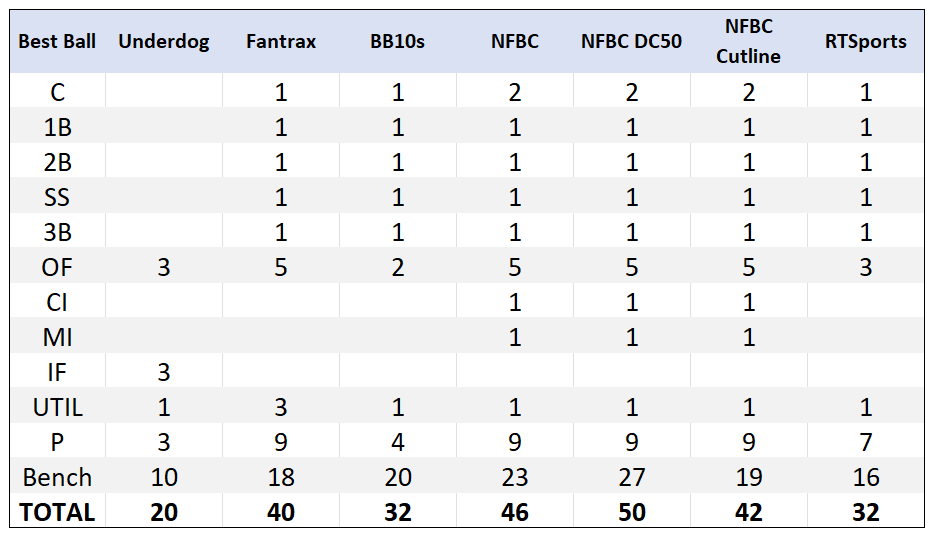Fantasy Baseball Best Ball

This piece will attempt to introduce the Best Ball novice to the basic concepts, roster construction, sites to use, and overarching strategy of a format that is booming in popularity.
What Is Best Ball?
Thought to have been introduced as a supplemental fantasy league between fantasy football experts in 1998, Best Ball was born with the goal of zero in-season management for the manager. What used to be calculated by hand is now done by a number of fantasy software platforms. Fantasy football popularized the recent boom in the Best Ball space and baseball has not been too far behind.
What Best Ball specifically does is take your optimal scoring lineup over a certain period of time and generate that score for you before comparing it to the rest of the league. These days, of course, the fantasy platform does the hard work. All we as managers have to do is draft and then check back at the end of the scoring period to check the points of our optimal lineup. Justin Verlander got hurt after just one inning as he did in 2020? No matter, the other pitcher scores on your roster will now be calculated towards the best ball total.
What is the Goal in Best Ball?
As you have likely determined, Best Ball is driven by a points-based format. You can forget rotisserie, you can forget weekly head-to-head for the most part, and you can forget worrying about anything other than what roster construction will earn me the most points throughout an entire season.
Baseball is famous for creating the rotisserie or 5×5 scoring system that has become so popular over the years. The strategy that works in that format can be thrown out the window when building a Best Ball team. All you care about is what combination of players will score the most points, most consistently.
You don’t have to worry about prioritizing things like steals or saves unless they fall to a point where they can most help your roster. Some sites, as we will see below, ignore saves and relief pitchers completely. You want points, points, and more points. Typically, the things that get you the most in these formats are extra-base hits, RBIs, innings, strikeouts, and wins.
Josh Hader’s not going to be drafted in the third round in these leagues, so don’t get sucked in by irrelevant Average Draft Positions.
What Sites Support the Best Ball Format?
There are any number of sites offering some kind of Best Ball product these days, but five sites now stand above the rest for the best product. Some of those sites have multiple types of Best Ball, but the basic idea is the same for all: draft the best ceiling + floor team and let the site do the work.
Here are the most common Best Ball sites and a couple of unique features of each:
Underdog – primarily a mobile interface (although you can draft on desktop), this is the easiest and fastest Best Ball game to play. They are famous for their mega-contests for football and baseball but also offer 10- or 12-person Best Ball league with winnings going to the top three finishers. For baseball season, they are offering a $25 tournament (the Dinger) and already a second version of the $5 tournament (the Bunt). For the Dinger, if you win the top prize at the end of the year and beat the other 4,511 entries, you take home a cool $20,000. For the Bunt, the top prize is $5,000.
>> Check out our Underdog Fantasy Review
Fantrax – one of the more innovative options for seasonal fantasy leagues now offers Best Ball options at the $10, $25, $50, and $100 levels. These are leagues with payouts to the top three winners. Fantrax also just unveiled their Beta draft room which makes drafting on desktop and mobile that much easier.
BB10s – This site which is a partner with NFC, does nothing but Best Ball in different sports all year round. They have unique Best Ball leagues such as classic, where almost 100% of the winnings go to first place, traditional leagues that pay out the top three, and 2x leagues where half of the league doubles their entry fee, similar to a 50/50 DFS contest.
NFC (or NFBC) – In what has become the industry standard for expert leagues and high-stakes leagues, NFC offers three distinct products. First is a traditional NFBC Best Ball league at all price points. Second is the popular DC50, where managers draft deep 50-man teams. The third is the NFBC Cutline tournament where your Best Ball score needs to be higher than a certain number to advance to various rounds throughout the season.
RTSports – RTSports also has a massive Best Ball tournament this season and has drafts starting multiple times during the day. This tournament with a maximum of 5,000 teams costs $20 to enter and awards a grand prize of $10,000 at the end as well as other prizes ranging from $5,000 to $100.
What do Best Ball Rosters Look Like?
Each site and each game are unique in their structure and composition. This simple guide should assist in what you need to fill in each format as well as the total number of players rostered for each.
Whether you want a quick, 20-man roster or a massive 50-player squad, you can find the right format for you. These sites offer a variety of fast- and slow-draft options, although the time to enter the slow drafts is ending soon.
Best Ball Roster Strategy
It doesn’t matter which site or roster format you choose, the goal for all of them is one and the same: maximize potential points. Assuming you are in a Best Ball format that has top-heavy awards (such as the top three get paid, with the majority going to first), there are a number of ways to approach your draft.
First, learn to love correlation with your hitters. This is one of the first lessons you learn in MLB DFS and it flows over to Best Ball as well. If a team such as the Dodgers scores 10 runs in one game, it’s impossible for just one or two guys to do all of that damage. Ten runs mean a lot of baserunners by way of hits or walks, it means a lot of batters driving people in, and it means there were likely a good number of extra-base hits. You will want to become familiar with the ADP of teammates on the site you use, so you can learn how to stack Freddie Freeman, Max Muncy, Will Smith, and Justin Turner, for example. Those guys, plus others you can take later, are likely to be heavily involved when the Dodgers have a big game. As Bobby Boucher said, “visualize and attack!” Know the offenses you want to target based on your draft slot and grab them.
That doesn’t mean you have to make every player in your lineup correlate to another, but stacks or minis-stacks on offense is something I always strive for.
For pitchers, I find it best to embrace the volatility after securing some stud anchors. With a Best Ball format, you can survive if your pitcher goes 2.1 innings and gives up nine runs. That score is very likely not to count towards the scoring period anyway so you can take some chances. A great example of this is one of my favorite Best Ball pitchers, German Marquez. Playing his entire career for Colorado you can imagine he has some wild home-road splits. It is true as his home ERA (4.73) is nearly a run higher than his road ERA (3.85). WHIP is exactly the same (1.36 at home, 1.19 on the road). But in this format, you avoid the do-I-or-don’t-I headache of whether or not to start him. You’re only going to get the best of his performances. And with a career of 9.0 K/9, he has plenty of good ones.
I also find myself with a bias towards pitchers who play on teams I know will win a lot of games. I understand that wins are often a stat that pitchers cannot control, but wins are so valuable in Best Ball, I feel I must set myself up with that perceived advantage.
My bench in Best Ball leagues typically is comprised of a backup catcher since they so frequently have days off and injuries, pitchers (considering their wild swings and propensity for injury), and outfielders. As you can see in the chart above, several sites require five outfielders in a legal roster. With that many per team in 12- or 15-team leagues, I want as many as possible in case of injury or poor performance.
One of my bench spots will also typically be reserved for a swiss-army-knife type of player. Someone who is eligible at multiple positions and can fill in several places in case of emergency.

